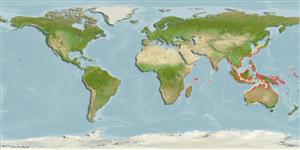Common names from other countries
>
Siluriformes (Catfishes) >
Ariidae (Sea catfishes) > Ariinae
Etymology: Arius: Greek, arios, areios = dealing with Mars, warlike, bellicose (Ref. 45335).
More on author: Hamilton.
Environment: milieu / climate zone / depth range / distribution range
Ecologia
marinhas; estuarina demersal; anfídromo (Ref. 51243). Tropical
Indo-West Pacific: India through neighboring coastal states (Pakistan, India, Bangladesh and Myanmar, Ref. 4833) to Singapore, South China Sea.
Tamanho / Peso / Idade
Maturity: Lm ? range ? - ? cm
Max length : 40.0 cm SL macho/indeterminado; (Ref. 38478); common length : 15.0 cm SL macho/indeterminado; (Ref. 4833)
Espinhos dorsais (total) : 1; Raios anais moles: 17 - 22. Head shield smooth anteriorly with a series of granules and rugae posteriorly. Adipose fin with a large black spot. Lateral line bifurcating at the base of tail. Gill rakers present on the hind aspect of all gill arches. Dorsal spine with a filament at its tip. Moderately deep caudal peduncle, 1.5 to 2.1 (mean 1.8) in its depth. (Ref. 38478).
Common in estuaries, tidal rivers and brackish water lakes. Feeds mostly on invertebrates. Caught mainly with bagnets, dipnets and bamboo stake traps, also on hook and line (Ref. 3290).
Life cycle and mating behavior
Maturities | Reprodução | Spawnings | Egg(s) | Fecundities | Larvas
Kailola, P.J., 1999. Ariidae (=Tachysuridae): sea catfishes (fork-tailed catfishes). p. 1827-1879. In K.E. Carpenter and V.H. Niem (eds.) FAO species identification guide for fishery purposes. The living marine resources of the Western Central Pacific. Vol. 3. Batoid fishes, chimaeras and bony fishes part 1 (Elopidae to Linophrynidae). FAO, Rome. (Ref. 38478)
Categoria na Lista Vermelha da IUCN (Ref. 130435)
CITES (Ref. 128078)
Not Evaluated
Ameaça para o homem
Traumatogenic (Ref. 58010)
Utilização humana
Pescarias: espécies comerciais
Ferramentas
Relatórios especiais
Descarregue XML
Fontes da internet
Estimates based on models
Preferred temperature (Ref.
115969): 24.9 - 29.2, mean 28.5 (based on 2376 cells).
Phylogenetic diversity index (Ref.
82804): PD
50 = 0.5000 [Uniqueness, from 0.5 = low to 2.0 = high].
Bayesian length-weight: a=0.00589 (0.00360 - 0.00963), b=3.13 (2.99 - 3.27), in cm Total Length, based on LWR estimates for this species & (Sub)family-body (Ref.
93245).
Nível Trófico (Ref.
69278): 3.5 ±0.37 se; based on food items.
Resiliência (Ref.
120179): Médio, tempo mínimo de duplicação da população 1,4 - 4,4 anos (Preliminary K or Fecundity.).
Fishing Vulnerability (Ref.
59153): Moderate vulnerability (39 of 100).
